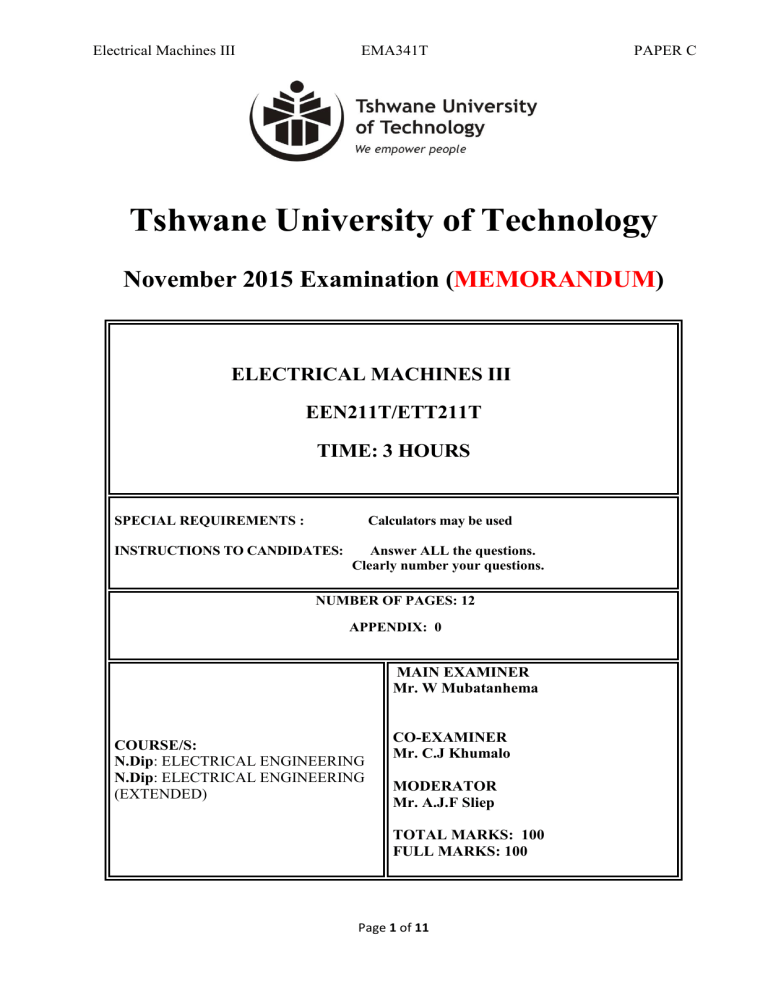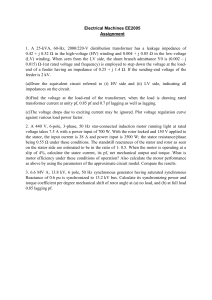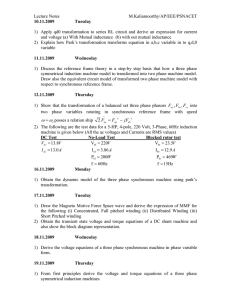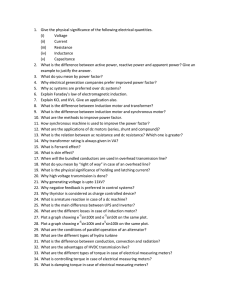
Electrical Machines III EMA341T PAPER C Tshwane University of Technology November 2015 Examination (MEMORANDUM) ELECTRICAL MACHINES III EEN211T/ETT211T TIME: 3 HOURS SPECIAL REQUIREMENTS : Calculators may be used INSTRUCTIONS TO CANDIDATES: Answer ALL the questions. Clearly number your questions. NUMBER OF PAGES: 12 APPENDIX: 0 MAIN EXAMINER Mr. W Mubatanhema COURSE/S: N.Dip: ELECTRICAL ENGINEERING N.Dip: ELECTRICAL ENGINEERING (EXTENDED) CO-EXAMINER Mr. C.J Khumalo MODERATOR Mr. A.J.F Sliep TOTAL MARKS: 100 FULL MARKS: 100 Page 1 of 11 Electrical Machines III EMA341T QUESTION 1 PAPER C [25] 1.1 With respect to transformers, carefully read the following statements and determine whether they are true or false (circle the right answer): (5) 1.1.1 The transformer core is made up of thin laminations of ferromagnetic material in order to minimize both eddy current and hysteresis losses. False 1.1.2 The transformation ratio of a three-phase transformer is independent of how the transformer is connected. False 1.1.3 The open-Δ transformer connection is limited to supplying almost 57.7% of a normal Δ- Δ transformer bank’s load. True 1.1.4 The per unit system of measurement eliminate the problem of different voltage levels in a power system. True 1.1.5 The open-circuit test essentially shows the copper (or I2R) losses. False 1.2 Three 40 MVA, 13.2/80 kV, 50 Hz, single-phase step-up transformers are connected wyedelta to form a three-phase transformer bank to feed a load of 90 MVA load. Evaluate the performance of this transformer bank by determining the following: 1.2.1 The loading of each transformer 1.2.2 The currents in the transformer windings 1.2.3 The incoming and outgoing transmission line currents 1.2.4 The primary and secondary line voltages (1) (2) (2) (2) 1.3 State the main conditions necessary before connecting two or more transformers in parallel? (4) 1.4 The results of open circuit and short circuit tests on a 600kVA, 3300/380 V, 50 Hz, Dyconnected three-phase transformer are as follows: Open circuit test: Secondary open circuited, with instrumentation on the low voltage side, input voltage 240V; input current 15.6A; input power, 810W. Short circuit test: The secondary short circuited, with instrumentation on the high voltage side. Input voltage 45 V; input current 38A; input power 1040W. Evaluate the performance of this transformer by determining the values of its approximate equivalent circuit referred to the primary side, its voltage regulation and efficiency under rated conditions at 0.8 pf lagging. (12) Page 2 of 11 Electrical Machines III EMA341T PAPER C Solution: 𝑆3∅ 1.2.1 Loading of each transformer, 𝑆∅ = 3 𝑆 1.2.2 Primary winding current, 𝐼𝑃∅ = 𝑉 ∅ = 𝑃∅ 90 𝑀𝑉𝐴 = 3 30×106 = 2 272.73 𝐴 13.2×103 𝑆 Secondary winding current, 𝐼𝑆∅ = 𝑉 ∅ = 𝑆∅ = 30 𝑀𝑉𝐴 30×106 80×103 = 375 𝐴 1.2.3 Incoming transmission line current, 𝐼𝑃𝐿 = 𝐼𝑃∅ = 2 272.73 𝐴 Outgoing transmission line current, 𝐼𝑆𝐿 = √3 𝐼𝑆∅ = √3 × 375 = 649.52 𝐴 1.2.4 Primary line voltage, 𝑉𝑃𝐿 = √3 𝑉𝑃∅ = √3 × 13.2 = 22.86 𝑘𝑉 Secondary line voltage, 𝑉𝑆𝐿 = 𝑉𝑆∅ = 80 𝑘𝑉 1.3 Necessary conditions before connecting two or more transformers in parallel a) b) c) d) Transformers must have same phase sequence Transformers must have same phase shift, i.e. belong to same vector group The voltage ratings and voltage ratios of the transformers should be the same Transformer impedances must be nearly the same 1.4 From the Open-circuit test (LV side: Y-connected): The per phase values are: VOCΦ = 240 √3 = 138.564 𝑉; IOCΦ = 15.6 𝐴; POCΦ = The excitation admittance is given by |𝑌𝐸𝑋 | = The admittance angle is 𝜃 = −𝑐𝑜𝑠 −1 (𝑉 𝐼𝑂𝐶Φ 𝑉𝑂𝐶Φ 𝑃𝑂𝐶Φ 𝑂𝐶Φ 𝐼𝑂𝐶Φ Therefore, 𝑌𝐸𝑋 = 1 𝑅𝐶 = 15.6 138.564 810 3 = 270 𝑊 = 0.112583 𝑆(1/2) 270 ) = −𝑐𝑜𝑠 −1 (138.564×15.6) = −82.83°(1/2) 1 − 𝑗 𝑋 = 0.112583 − 82.83° = 0.01405 − j0.1117(1/2) 𝑀 1 𝑅𝐶(𝐿𝑉) = 0.01405 = 71.2 Ω (1/2) 1 𝑋𝑀(𝐿𝑉) = 0.1117 = 8.95 Ω (1/2) √3×3300 Turns ratio is 𝑎 = 380 = 15.041 (1/2) Referring RC and XM to the HV side: 𝑅𝐶(𝐻𝑉) = 𝑎2 𝑅𝐶(𝐿𝑉) = 15.0412 × 71.2 = 16.11 𝑘Ω (1/2) Page 3 of 11 Electrical Machines III EMA341T PAPER C 𝑋𝑀(𝐻𝑉) = 𝑎2 𝑋𝑀(𝐿𝑉) = 15.0412 × 8.95 = 2.02 𝑘Ω (1/2) From the Short-circuit test (HV side: Δ-connected): The per phase values are: VSCΦ = 45 𝑉; ISCΦ = The series impedance is given by |𝑍𝐸𝑄 | = The impedance angle is 𝜃 = 𝑐𝑜𝑠 −1 (𝑉 𝑉𝑆𝐶Φ 𝐼𝑆𝐶Φ 𝑃𝑆𝐶Φ 𝑆𝐶Φ 𝐼𝑆𝐶Φ 38 √3 = = 21.94 𝐴; PSCΦ = 45 3 = 346.67 𝑊 = 2.0510 Ω (1/2) 21.94 −1 ) = 𝑐𝑜𝑠 1040 346.67 (45×21.94) = 69.44°(1/2) Therefore, 𝑍𝐸𝑄 = 𝑅𝐸𝑄 + 𝑗𝑋𝐸𝑄 = 2.051069.44° = (0.72 + j1.92) Ω The equivalent circuit: 𝑆 Full load secondary current, 𝐼2Φ = 3𝑉3Φ = 𝑠Φ 600000 3 ×380⁄ √3 = 911.61 𝐴 (1/2) ′ Full load secondary current referred to primary side, 𝐼2Φ = 𝐼2Φ 𝑎 = 60.61 𝐴 (1/2) ′ Primary voltage, 𝑉1 = 𝑉2′ + 𝐼2Φ (𝑅𝐸𝑄 + 𝑗𝑋𝐸𝑄 ) = 3300 + (60.61 − 36.87°)(0.72 + j1.92) = 3405.391.13° V(1/2) %𝑉𝑅 = 𝑉𝑆(𝑁𝐿) −𝑉𝑆(𝐹𝐿) 𝑉𝑆(𝐹𝐿) × 100% = 3405.39−3300 3300 × 100% ≈ 3.2% 60.61 2 Copper loss at full load, 𝑃𝐶𝑈(𝐹𝐿) = (21.94) (1040) = 7936.86 𝑊(1/2) Efficiency = 𝑃𝑜𝑢𝑡 𝑃𝑖𝑛 = 𝑆𝑐𝑜𝑠∅ 𝑆𝑐𝑜𝑠∅+𝑃𝑐𝑢 +𝑃𝑓𝑒 × 100% = 600000×0.8 600000×0.8+7936.86+810 Page 4 of 11 × 100% = 98.2% Electrical Machines III EMA341T PAPER C QUESTION 2 [26] 2.1 How does a three-phase induction motor develop torque? (3) 2.2 Sketch a typical induction motor torque vs speed characteristic curve (3) 2.3 An induction motor is running at rated conditions. If the shaft load is suddenly increased, how do the following variables change? (5) 2.3.1 Mechanical speed 2.3.2 Synchronous speed 2.3.3 Slip 2.3.4 Rotor frequency 2.3.5 Rotor induced voltage 2.4 A 440 V, 50 Hz, 275 kW, six-pole, D- connected induction motor has the following impedances in ohms per phase referred to the stator circuit: R1 = 0.082 Ω R2 = 0.070 Ω X1 = 0.190 Ω X2 = 0.180 Ω XM = 7.2 Ω PF&W = 1.3 kW Pcore = 1.4 kW Pmisc = 150 W For a slip of 4%, determine: 2.4.1 The stator current 2.4.2 The stator copper losses, PSCL 2.4.3 The air-gap power, PAG 2.4.4 The developed mechanical power, Pm 2.4.5 Induced torque, τind 2.4.6 The overall machine efficiency, 𝜂 (2) (2) (3) (2) (3) (3) Solution: 2.1 When a 3-phase supply is applied to the stator of a 3-phase induction motor, a rotating magnetic field is produced in the stator winding. This rotating magnetic field passes through the air-gap and cuts the rotor conductors. This induces an emf in the rotor winding (Faraday’s law of electromagnetic induction) causing a current to flow in the rotor winding, and this produces the rotor torque. 2.2 Three-phase induction motor torque vs speed characteristic Page 5 of 11 Electrical Machines III EMA341T PAPER C 2.3 When the shaft load is suddenly increased: 2.3.1 Mechanical speed decreases 2.3.2 Synchronous speed remains unchanged 2.3.3 Slip increases 2.3.4 Rotor frequency increases 2.3.5 Rotor induced voltage increases 2.4.1 The equivalent circuit of this 3-phase induction motor: The equivalent impedance of rotor circuit in parallel with jXM: 1 1 𝑍𝐹 = 1 1 = 1 = 1.577 + 𝑗0.550(1/2) 1 + 𝑗𝑋𝑀 𝑍2 + 𝑗7.2 1.75+𝑗0.18 The total impedance of induction motor, 𝑍𝑇 = 𝑍1 + 𝑍𝐹 = (0.082 + 𝑗0.19) + (1.577 + 𝑗0.550) = 1.816624.04° Ω (1/2) The phase voltage, 𝑉𝛷 = 440 𝑉(1/2) The stator current, 𝐼1 = 𝑉𝛷 𝑍𝑇 2.4.2 The stator copper losses, = 4400° = 242.21 − 24.04° A(1/2) 1.816624.04° 𝑃𝑆𝐶𝐿 = 3𝐼12 𝑅1 = 3 × 242.212 × 0.082 = 14. 43 𝑘𝑊 Page 6 of 11 Electrical Machines III EMA341T PAPER C 2.4.3 Motor input power, 𝑃𝐼𝑁 = 3𝑉𝛷 𝐼1 𝑐𝑜𝑠𝜃 = 3 × 440 × 242.21 × cos 24.04° = 292.0 𝑘𝑊 Air-gap power, 𝑃𝐴𝐺 = 𝑃𝐼𝑁 − 𝑃𝑆𝐶𝐿 − 𝑃𝑐𝑜𝑟𝑒 = 292.0 − 14.43 − 1.4 = 276.16 𝑘𝑊 2.4.4 The developed mechanical power, 𝑃𝑚 = (1 − 𝑠)𝑃𝐴𝐺 = (1 − 0.04) × 276.16 = 265.11 𝑘𝑊 2.4.5 Synchronous speed of the motor, 𝑛𝑠 = 120𝑓 𝑝 = Therefore, the induced torque, 𝜏𝑖𝑛𝑑 = 9.55 × 120×50 6 𝑃𝐴𝐺 𝑛𝑠 = 1000 𝑟𝑝𝑚 = 9.55 × 276.16 1000 ≈ 2.64 𝑘𝑁𝑚 2.4.6 Motor output power, 𝑃𝑂𝑈𝑇 = 𝑃𝑚 − P𝐹&𝑊 − 𝑃𝑚𝑖𝑠𝑐 = 265.11 − 1.3 − 0.150 = 263.66 𝑘𝑊 Motor efficiency, 𝜂= 𝑃𝑂𝑈𝑇 𝑃𝐼𝑁 × 100% = 263.66 292.0 × 100% = 90.3% Page 7 of 11 Electrical Machines III EMA341T PAPER C QUESTION 3 [24] 3.1 With respect to single-phase induction motors, briefly answer the following questions: 3.1.1 A single-phase induction motor cannot self-start. True or False. Explain. (2) 3.1.2 How does an auxiliary winding provide a starting torque in the machine? (2) 3.1.3 How is the current phase shift accomplished in the auxiliary winding of a split-phase induction motor? (2) 3.1.4 How does the starting torque of a split-phase motor compare to that of a capacitor-start motor? (2) 3.1.5 How is starting torque produced in a shaded-pole motor? (2) 3.2 A 220 V, 50 Hz, 0.50 hp, 4-pole, resistance split-phase induction motor has the following main winding impedances: R1 = 1.78 Ω X1 = 2.85 Ω R2 = 2.46 Ω X2 = 2.85 Ω XM = 88 Ω PF&W = 45 W For a slip of 4%, determine: 3.2.1 The stator current 3.2.2 The input power, Pin 3.2.3 The air-gap power, PAG 3.2.4 The developed mechanical power, Pm 3.2.5 The output power, Pout 3.2.6 The overall machine efficiency, 𝜂 (3) (2) (3) (2) (2) (2) Solution: 3.1.1 True. When a single-phase supply is applied to the stator of a single-phase induction motor, a pulsating (or alternating) magnetic field is produced in the stator winding. A pulsating magnetic field cannot produce rotation, so a single-phase induction motor cannot self-start. 3.1.2 The auxiliary winding is designed in such a way that there is a phase difference between the currents flowing in the auxiliary winding and the main winding. This phase difference enables a rotating magnetic field to be produced in the stator winding, which then produces the motor torque, i.e. T = kImIa sinα. 3.1.3 In a split-phase induction motor, the auxiliary winding is designed to have a higher resistance/reactance ratio than the main winding, so that the current in the auxiliary winding leads the current in the main winding. 3.1.4 The starting torque of a split-phase motor is lower than that of a capacitor-start motor. Page 8 of 11 Electrical Machines III EMA341T PAPER C 3.1.5 A shaded-pole motor has only a main winding and salient poles, with one portion of each pole surrounded by a short-circuited coil. A time varying revolving flux is induced in the poles by the main winding. 3.2.1 Forward impedance 𝑍𝐹 : 1 1 𝑍𝐹 = 𝑗𝑥 + 𝑚 1 𝑟 ( 2⁄𝑠+𝑗𝑥2 ) 𝑍𝐹 = 24.69236.75° Ω (1/2) 1 Backward impedance 𝑍𝐵 : 𝑍𝐵 1 = 𝑗𝑥 + 𝑚 1 𝑟2 ( ⁄2−𝑠+𝑗𝑥2 ) 𝑍𝐵 = 1.50867.02° Ω (1/2) Total impedance 𝑍𝑇 = 𝑍1 + 𝑍𝐹 + 𝑍𝐵 = 29.19340.64° Ω 𝑉 The stator current, 𝐼1 = 𝑍 = 𝑇 2200° 29.19340.64° = 7.54 − 40.64° A 3.2.2 Power input, 𝑃𝑖𝑛 = 𝑉𝐼𝑐𝑜𝑠∅ = 220 × 7.54 × 𝑐𝑜𝑠 40.64° = 1258.06 W 3.2.3 Forward air-gap power, 𝑃𝑎𝑔𝐹 = 𝐼12 𝑅𝐹 = 1124.82 𝑊 Backward air-gap power, 𝑃𝑎𝑔𝐵 = 𝐼𝐵2 𝑅𝐵 = 33.47 𝑊 Air-gap power, 𝑃𝑎𝑔 = 𝑃𝑎𝑔𝐹 − 𝑃𝑎𝑔𝐵 = 1091.35 𝑊 3.2.4 Mechanical power developed, 𝑃𝑚 = (1 − 𝑠)𝑃𝑎𝑔 = 1047.70 𝑊 3.2.5 Motor output power, 𝑃𝑜𝑢𝑡 = 𝑃𝑚 − P𝐹&𝑊 − 𝑃𝑚𝑖𝑠𝑐 = 1002.70.00 𝑊 3.2.6 Motor efficiency, 𝜂= 𝑃𝑜𝑢𝑡 𝑃𝑖𝑛 1002.70 × 100% = 1258.06 × 100% = 79.70 % Page 9 of 11 Electrical Machines III EMA341T QUESTION 4 PAPER C [22] 4.1 With respect to synchronous machines: 4.1.1 Briefly explain how a synchronous generator develops electrical energy from mechanical energy (3) 4.1.2 Briefly explain how you would determine the synchronous reactance of a given synchronous generator in the laboratory (5) 4.2 A 360 V, 50 Hz, Y-connected, 2-pole synchronous generator has the OCC shown in the figure below. This generator has a synchronous reactance of 0.32 Ω and armature resistance of 0.012 Ω. At full-load, the machine supplies 300 A at 0.9 PF lagging. Under full-load conditions, the friction and windage losses are 15 kW, and the core losses are 20 kW. Ignore any field circuit losses. 4.2.1 How much field current must be supplied to the generator to make the terminal voltage 360 V at no-load? (2) 4.2.2 Under full-load conditions, how much field current will be required to keep the terminal voltage equal to 360 V? (4) 4.2.3 Under full-load conditions, how much power is the generator supplying? How much power is supplied by the prime mover? What is the machine’s voltage regulation and efficiency? (8) Solution: Page 10 of 11 Electrical Machines III EMA341T PAPER C 4.1.1 The prime mover (or turbine) drives the rotor and provides the mechanical energy. A dc current flowing in the rotor (or field) winding produces a rotating magnetic field, which cuts the armature winding (on the stator), so inducing an emf. 4.1.2 Procedure for determining the synchronous reactance, XS: (a) Firstly, carry out DC test to determine the armature resistance Ra (b) Secondly, carry out Open-circuit test and plot OCC (c) Thirdly, carry out Short-circuit test and plot SCC (d) Finally, determine the full-load current ISC and read the corresponding field current from SCC. For the same field current, read the corresponding open-circuit voltage VOC. 𝑉 The synchronous impedance, 𝑍𝑆 ≈ 𝐼 𝑂𝐶 . Then, the synchronous reactance, 𝑋𝑆 = 𝑆𝐶 √𝑍𝑆2 − 𝑅𝑎2 4.2.1 At no-load, 𝐼𝑎 = 0, so 𝐸𝑎𝐿𝐿 = 𝑉𝑇𝐿𝐿 = 360 𝑉 From OCC, with 𝑉𝑇𝐿𝐿 = 480 𝑉, 𝐼𝑓 = 3.0 𝐴 4.2.2 Terminal phase voltage, 𝑉𝑇𝛷 = 360 √3 = 207.85 𝑉(1/2) Full load armature current, 𝐼𝑎 = 300 − 25.84° A(1/2) Internal generated voltage, 𝐸𝑎 = 𝑉𝑇𝛷 + 𝐼𝑎 (𝑅𝑎 + 𝑗𝑋𝑆 ) = 207.850° + (300 − 25.84° )(0.012 + 𝑗0.32) = 266.7818.54° V 𝐸𝑎𝐿𝐿 = √3 × 266.78 = 462.07 𝑉 From OCC, with 𝑉𝑇𝐿𝐿 ≈ 462 𝑉, 𝐼𝑓 ≈ 4.3 𝐴 4.2.3 Power supplied by generator, 𝑃𝑜𝑢𝑡 = √3𝑉𝑇 𝐼𝑎 × 𝑃𝐹 = 168.36 𝑘𝑊 Copper losses, 𝑃𝑐𝑢 = 3𝐼𝑎2 𝑅1 = 3.24 𝑘𝑊 Power supplied by prime mover, 𝑃𝑖𝑛 = 𝑃𝑜𝑢𝑡 + 𝑃𝑐𝑢 + 𝑃𝑐𝑜𝑟𝑒 + 𝑃𝑤+𝑓 = 206.6 𝑘𝑊 Voltage regulation, 𝑉𝑅 = Machine efficiency, 𝜂= 𝐸𝑎 − 𝑉𝑇 𝑃𝑜𝑢𝑡 𝑃𝑖𝑛 𝑉𝑇 = 266.78−207.85 207.85 × 100% = 168.36 206.6 × 100 = 28.4 % × 100% = 81.5% Page 11 of 11





